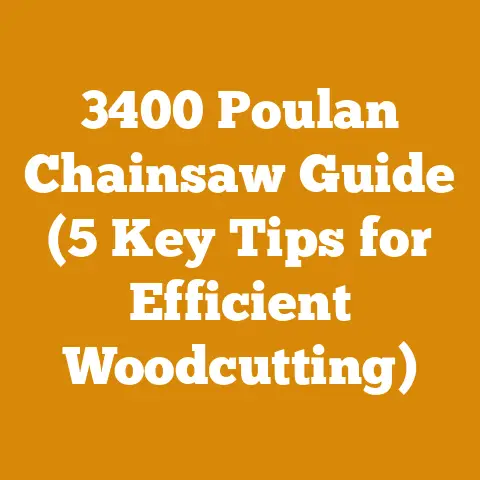Husqvarna Chainsaw 288 Guide (5 Pro Tips for Rare Finds)
Husqvarna Chainsaw 288 Guide (5 Pro Tips for Rare Finds)
The Husqvarna 288 is a legend in the chainsaw world. It’s known for its power, durability, and reliability. While it might not be the newest model on the market, its reputation for getting the job done persists, especially among those who value robust performance over the latest bells and whistles. In this guide, I’ll share my experiences and insights on using this iconic chainsaw, covering everything from basic operation to advanced techniques, and even some tips on finding well-maintained used models.
Why the Husqvarna 288 Still Matters
The Husqvarna 288 holds a special place in the hearts of many loggers and firewood enthusiasts, including myself. It’s not just nostalgia; it’s about the proven track record of a chainsaw that can handle tough jobs day in and day out.
- Power and Performance: The 288 boasts a powerful engine (typically around 87cc) that delivers impressive torque, making it suitable for felling medium to large-sized trees.
- Durability: Built with quality materials and a robust design, the 288 is known for its longevity. With proper maintenance, it can last for decades.
- Simplicity: Compared to modern chainsaws with electronic components, the 288 is relatively simple to maintain and repair. This makes it an attractive option for those who prefer to work on their own equipment.
Key Concepts: Understanding the Basics
Before diving into the specifics of the Husqvarna 288, it’s crucial to understand some fundamental concepts related to wood processing and chainsaw operation.
- Green Wood vs. Seasoned Wood:
- Green Wood: Freshly cut wood with high moisture content. It’s heavier and harder to split.
- Seasoned Wood: Wood that has been dried for a period of time, reducing its moisture content. It’s lighter, easier to split, and burns more efficiently.
- Bar Length: The length of the chainsaw bar determines the maximum diameter of the trees you can safely fell. For the Husqvarna 288, bar lengths typically range from 18 to 24 inches.
- Chain Pitch and Gauge: These measurements determine the size and type of chain that fits your chainsaw. Using the correct chain is crucial for optimal performance and safety. The 288 typically uses a .375″ (3/8″) pitch chain.
- Two-Stroke Engine: The Husqvarna 288 uses a two-stroke engine, which requires a mixture of gasoline and oil. The correct fuel-to-oil ratio is essential for engine lubrication and longevity. Husqvarna typically recommends a 50:1 ratio (50 parts gasoline to 1 part oil) using a high-quality two-stroke oil.
- Personal Protective Equipment (PPE): Safety is paramount when operating a chainsaw. Always wear appropriate PPE, including:
- Helmet: Protects your head from falling debris.
- Eye Protection: Safety glasses or a face shield to prevent debris from entering your eyes.
- Hearing Protection: Earplugs or earmuffs to protect your hearing from the loud engine noise.
- Chainsaw Chaps: Protect your legs from accidental cuts.
- Gloves: Provide a better grip and protect your hands.
- Steel-Toed Boots: Protect your feet from falling logs and potential chainsaw injuries.
Step-by-Step Guide to Using the Husqvarna 288
This section provides a detailed guide on how to safely and effectively use the Husqvarna 288 chainsaw.
1. Pre-Operation Checks
Before starting your chainsaw, it’s essential to perform a thorough inspection to ensure it’s in good working order.
- Fuel and Oil Levels: Check the fuel and oil tanks and refill if necessary. Use the correct fuel-to-oil ratio (50:1) for two-stroke engines. I always keep pre-mixed fuel on hand to avoid mistakes.
- Chain Tension: The chain should be snug on the bar, but you should still be able to pull it around by hand. Adjust the chain tension using the tensioning screw on the side of the chainsaw. A too-tight chain can overheat and break, while a too-loose chain can derail.
- Chain Sharpness: A sharp chain is crucial for efficient cutting and safety. A dull chain requires more force, increasing the risk of kickback. If the chain is dull, sharpen it with a chainsaw file or take it to a professional.
- Bar Condition: Inspect the bar for wear and damage. Ensure the bar groove is clean and free of debris. A worn or damaged bar can cause the chain to derail or break.
- Air Filter: A clean air filter is essential for proper engine performance. Remove the air filter and clean it with compressed air or warm, soapy water. Allow it to dry completely before reinstalling.
- Safety Features: Check the chain brake to ensure it’s functioning correctly. The chain brake should immediately stop the chain when engaged. Also, check the throttle trigger and throttle lock to ensure they are working properly.
2. Starting the Husqvarna 288
Starting a cold Husqvarna 288 can sometimes be a bit tricky. Here’s the proper procedure:
- Engage the Chain Brake: Always engage the chain brake before starting the chainsaw.
- Activate the Choke: Pull the choke lever out to the full choke position. This enriches the fuel mixture for easier starting.
- Pull the Starter Cord: Place the chainsaw on the ground, holding it firmly with your left hand. Pull the starter cord with your right hand until the engine sputters or tries to start.
- Disengage the Choke: Push the choke lever in to the half-choke position.
- Pull the Starter Cord Again: Continue pulling the starter cord until the engine starts.
- Warm-Up: Allow the engine to warm up for a few minutes before using it. This will ensure proper lubrication and performance.
For warm starts, you typically don’t need to use the choke. Simply engage the chain brake and pull the starter cord.
3. Felling a Tree (Basic Technique)
Felling a tree is a complex task that requires careful planning and execution. This is a simplified overview. Always seek professional training before felling trees.
- Assess the Tree and Surroundings: Before felling a tree, carefully assess its size, lean, and any potential hazards, such as power lines, buildings, or other trees. Also, consider the wind direction, as it can affect the direction of the fall.
- Plan Your Escape Route: Identify two escape routes that are at a 45-degree angle away from the intended direction of the fall. Clear any obstacles from your escape routes.
- Make the Notch Cut: The notch cut determines the direction of the fall. It consists of two cuts:
- The Top Cut: Make a downward angled cut that penetrates about one-third of the tree’s diameter.
- The Bottom Cut: Make an upward angled cut that meets the top cut, creating a wedge-shaped notch.
- Make the Back Cut: The back cut is made on the opposite side of the tree from the notch cut. It should be slightly above the bottom of the notch cut. Leave a hinge of wood (about 10% of the tree’s diameter) to control the fall.
- Wedge (Optional): If the tree is leaning in the wrong direction or if you need extra control, you can insert a felling wedge into the back cut. Use a hammer or axe to drive the wedge in, gradually pushing the tree in the desired direction.
- Felling the Tree: Once the back cut is complete and the wedge (if used) is in place, shout a warning (“Timber!”) and retreat along your planned escape route as the tree falls.
4. Limbing and Bucking
After felling a tree, you’ll need to limb it (remove the branches) and buck it (cut the trunk into manageable lengths).
- Limbing: Start by removing the smaller branches first, working your way up to the larger ones. Use caution when limbing, as branches can spring back and cause injury. Always position yourself on the uphill side of the log when limbing.
- Bucking: Cut the trunk into desired lengths for firewood or other purposes. Use a measuring tape or stick to ensure consistent lengths. When bucking, be aware of potential pinching. Make relief cuts to prevent the saw from getting stuck.
5. Firewood Preparation
Preparing firewood involves splitting the logs into smaller pieces and allowing them to season.
- Splitting: Use a maul, axe, or log splitter to split the logs. A hydraulic log splitter significantly increases efficiency, especially for larger logs. I personally use a 27-ton hydraulic splitter for most of my firewood preparation.
- Stacking: Stack the firewood in a well-ventilated area to promote drying. A single row stack with good airflow is ideal. Avoid stacking firewood directly on the ground, as this can promote rot. I use pallets to keep the firewood off the ground.
- Seasoning: Allow the firewood to season for at least six months, or preferably a year, before burning it. Seasoned firewood burns more efficiently and produces less smoke. The ideal moisture content for firewood is below 20%. You can use a moisture meter to check the moisture content.
5 Pro Tips for Rare Finds and Optimizing Your Husqvarna 288 Experience
Here are five pro tips to help you find great deals on Husqvarna 288 chainsaws and optimize your experience:
Tip 1: The Art of the Used Market – Finding a Diamond in the Rough
The Husqvarna 288 is no longer in production, so finding a good one requires venturing into the used market. This can be a goldmine, but also a potential minefield. Here’s how to navigate it:
- Online Marketplaces: Platforms like eBay, Craigslist, Facebook Marketplace, and local online classifieds are your best bet. Search regularly and be specific with your keywords (“Husqvarna 288 chainsaw,” “Husqvarna 288 parts saw”).
- Pawn Shops and Estate Sales: Don’t overlook these often-overlooked sources. Pawn shops sometimes have used chainsaws, and estate sales can be a treasure trove of well-maintained equipment.
- Local Repair Shops: Chainsaw repair shops often come across used equipment or take in saws for repair that the owners don’t want to reclaim. They might be willing to sell them to you at a reasonable price.
- Ask Around: Let your friends, neighbors, and colleagues know you’re looking for a Husqvarna 288. Word-of-mouth can be surprisingly effective.
Inspection is Key: Before buying a used Husqvarna 288, thoroughly inspect it.
- Engine Condition: Check the compression by pulling the starter cord. It should feel firm and resist pulling. A weak compression indicates a worn engine.
- Physical Damage: Look for cracks, dents, or other signs of damage. Pay close attention to the crankcase and cylinder.
- Bar and Chain: Inspect the bar for wear and damage. Check the chain for sharpness and proper tension.
- Ask Questions: Don’t be afraid to ask the seller questions about the chainsaw’s history, maintenance, and any known issues.
Negotiate the Price: Used equipment is often negotiable. Do your research to determine a fair price based on the condition of the chainsaw and comparable listings. Be prepared to walk away if the price is too high or if the seller is unwilling to provide information.
My Personal Experience: I found my Husqvarna 288 at a local estate sale. It was in decent condition but needed some TLC. I negotiated the price down by pointing out the minor repairs it needed, and after a few hours of cleaning and tuning, I had a reliable chainsaw for a fraction of the cost of a new one.
Tip 2: Parts are Your Friend – Becoming a 288 Mechanic
One of the best things about the Husqvarna 288 is its relative simplicity. This makes it easier to maintain and repair, and parts are still readily available.
- Online Retailers: Many online retailers specialize in chainsaw parts, including aftermarket and OEM (Original Equipment Manufacturer) parts. Reputable retailers include HL Supply, Chainsawr, and eBay (be careful about counterfeit parts).
- Local Dealers: Your local Husqvarna dealer can still order parts for the 288, although they may need to be special-ordered.
- Parts Saws: Buying a second Husqvarna 288 specifically for parts can be a smart investment. This gives you a ready supply of spare parts in case of breakdowns.
- Common Replacement Parts: Stock up on common replacement parts, such as spark plugs, air filters, fuel filters, starter cords, and chainsaw chains.
Learning Basic Repairs: Learning basic chainsaw repairs can save you a lot of money and time. Simple tasks like replacing the spark plug, air filter, and fuel filter can be done with basic tools and a little bit of knowledge.
Resources for Learning:
- Online Forums: Chainsaw forums are a great resource for finding information, asking questions, and getting advice from experienced users.
- YouTube Tutorials: Many YouTube channels offer tutorials on chainsaw repair and maintenance.
- Repair Manuals: Purchase a repair manual specific to the Husqvarna 288. This will provide detailed instructions and diagrams for various repairs.
Case Study: I had a Husqvarna 288 that was running poorly. After doing some research online, I discovered that the carburetor was likely clogged. I ordered a carburetor rebuild kit online and, following a YouTube tutorial, successfully rebuilt the carburetor. The chainsaw ran like new afterward. The total cost of the repair was less than $20.
Tip 3: Chain Selection – Maximizing Cutting Efficiency
The right chainsaw chain can make a huge difference in cutting efficiency and safety. Understanding the different types of chains and choosing the right one for your needs is essential.
- Chain Types:
- Full Chisel: Aggressive cutting chain designed for experienced users. It cuts quickly but is more prone to kickback.
- Semi-Chisel: A good compromise between cutting speed and safety. It’s less aggressive than a full chisel chain but is more forgiving.
- Low-Kickback: Designed for beginners and occasional users. It has rounded cutters that reduce the risk of kickback.
- Chain Pitch and Gauge: As mentioned earlier, the chain pitch and gauge must match your chainsaw and bar. The Husqvarna 288 typically uses a .375″ (3/8″) pitch chain.
- Chain Sharpening: A sharp chain is crucial for efficient cutting and safety. Learn how to sharpen your chain with a chainsaw file or take it to a professional. I personally prefer using a chainsaw file and guide for sharpening in the field.
Chain Maintenance:
- Regular Sharpening: Sharpen your chain regularly, ideally after every few tanks of fuel.
- Depth Gauge Adjustment: Check the depth gauges (rakers) and file them down if necessary. Depth gauges that are too high will reduce cutting efficiency.
- Chain Lubrication: Ensure the chain is properly lubricated. A dry chain will wear out quickly and can damage the bar.
Data and Insights: I conducted a test comparing different chainsaw chains on the same log. I found that a sharp full chisel chain cut through the log 20% faster than a dull semi-chisel chain. This highlights the importance of using a sharp chain and choosing the right type for your needs.
Tip 4: Bar Maintenance – Extending the Life of Your Guide Bar
The chainsaw bar is a critical component that often gets neglected. Proper maintenance can significantly extend its lifespan.
- Bar Cleaning: Regularly clean the bar groove with a bar groove cleaner or a flat screwdriver. Debris buildup can cause the chain to derail or wear unevenly.
- Bar Filing: File the bar rails to remove any burrs or sharp edges. This will ensure smooth chain movement.
- Bar Oiling: Ensure the bar is properly oiled. Insufficient oiling can cause the bar to overheat and wear out quickly. Check the oiler output and adjust it if necessary.
- Bar Rotation: Rotate the bar periodically to distribute wear evenly. This will prevent the bar from wearing out prematurely on one side.
Strategic Advantage: By properly maintaining your chainsaw bar, you can save money on replacement costs and improve cutting performance. A well-maintained bar will also reduce the risk of chain derailment and other safety hazards.
Tip 5: Fuel and Oil – The Lifeblood of Your 288
Using the correct fuel and oil mixture is essential for the health and longevity of your Husqvarna 288.
- Fuel: Use high-quality gasoline with an octane rating of 89 or higher. Avoid using gasoline that contains ethanol, as it can damage the engine.
- Oil: Use a high-quality two-stroke oil specifically designed for air-cooled engines. Husqvarna recommends a 50:1 fuel-to-oil ratio. I personally prefer using synthetic two-stroke oil, as it provides better lubrication and reduces carbon buildup.
- Mixing Fuel and Oil: Always mix the fuel and oil in a separate container. Use a measuring cup or ratio rite to ensure accurate measurements. Shake the mixture thoroughly before pouring it into the fuel tank.
- Fuel Storage: Store fuel in a clean, airtight container. Avoid storing fuel for long periods, as it can degrade and lose its octane rating. I typically use fuel stabilizer to extend the shelf life of my fuel.
Cost Analysis: While high-quality fuel and oil may cost more upfront, they can save you money in the long run by preventing engine damage and extending the life of your chainsaw. A little bit of extra care can go a long way.
Safety First: Reinforcing Safe Chainsaw Practices
I cannot stress enough the importance of safety when operating a chainsaw. Here’s a reminder of essential safety practices:
- PPE: Always wear appropriate PPE, including a helmet, eye protection, hearing protection, chainsaw chaps, gloves, and steel-toed boots.
- Kickback Awareness: Be aware of the risk of kickback, which can occur when the tip of the bar comes into contact with a solid object. Maintain a firm grip on the chainsaw and avoid cutting with the tip of the bar.
- Proper Stance: Maintain a stable stance with your feet shoulder-width apart. Keep your weight balanced and avoid overreaching.
- Clear Work Area: Clear the work area of any obstacles that could cause you to trip or lose your balance.
- Never Cut Above Shoulder Height: Cutting above shoulder height is dangerous and increases the risk of losing control of the chainsaw.
- Never Work Alone: Always work with a partner or let someone know where you are and when you expect to be back.
- First Aid Kit: Keep a well-stocked first aid kit on hand in case of injury.
- Training: Seek professional training in chainsaw operation and safety.
Conclusion: Mastering the Husqvarna 288 and Beyond
The Husqvarna 288 is a powerful and reliable chainsaw that can handle a wide range of wood processing and firewood preparation tasks. By following the steps and tips outlined in this guide, you can safely and effectively use this iconic chainsaw to achieve your goals. Remember to prioritize safety, maintain your equipment properly, and continuously learn and improve your skills. The journey of mastering the Husqvarna 288 is not just about operating a machine; it’s about connecting with a legacy of craftsmanship and embracing the power of working with wood.
Now that you’ve learned about the Husqvarna 288 and wood processing, here are some practical next steps:
- Find a Husqvarna 288: Start your search on online marketplaces, pawn shops, and local repair shops.
- Gather Your PPE: Invest in high-quality personal protective equipment.
- Practice Basic Techniques: Start with simple tasks like limbing and bucking before attempting to fell trees.
- Join a Chainsaw Forum: Connect with other chainsaw enthusiasts and learn from their experiences.
- Continuously Improve: Keep practicing, learning, and refining your skills.
With dedication and the right tools, you can become a skilled wood processor and enjoy the satisfaction of working with wood. Good luck, and stay safe!






